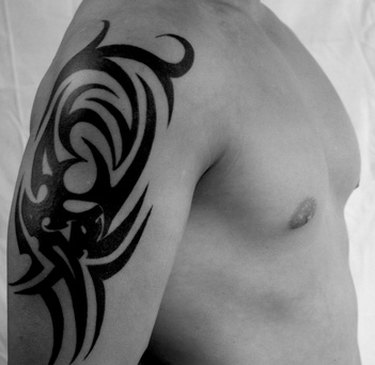Things You'll Need
Soap
Water
Paper towels
Gloves
Green soap
Distilled water
Bowl
Funnel
Autoclave bottle

After a tattoo artist draws a tattoo for a client, he feeds his design through a machine to create a stencil. With the stencil ready, the tattoo artist carefully cleans the skin of the client and shaves any hair from the body part that will receive the tattoo. Gloves protect the client and tattoo artist from bacteria and bodily fluids exuding from the client's broken skin during the tattoo process. The germicidal spray the tattoo artist uses to clean the client's skin offers further protection by removing possibly infectious waste. The spray, or transfer solution, is easy to make but care must be taken to keep it sterile.
Step 1
Wash your hands with a mild soap and warm water. Dry your hands with a paper towel. Use the paper towel to turn off the faucet, then put on a pair of sterile gloves. Nitrile gloves remove the risk of the stencil solution harboring latex properties and are a good option for working with clients who may have latex allergies.
Video of the Day
Step 2
Mix 10 parts of liquid green soap and one part of distilled water in a disposable, clean bowl. This mixtureis the transfer solution. Sterilize an autoclave-friendly bottle in the shop autoclave to store the solution. Sterilizing the bottle ensures the cleanest receptacle for the solution and reduces the possibility of bacteria reaching the client's skin.
Step 3
Place a funnel into the neck of an autoclave friendly bottle or spray bottle. Pour the mixture into the funnel. Screw on the top of the bottle. Properly dispose of the gloves, bowl and funnel.
Tip
Do not touch the tip of the bottle to any surface or the transfer solution is considered contaminated and must be disposed.
Spray the transfer solution on a clean paper towel and apply it to the client before adhering the stencil.
Warning
Never attempt a tattoo unless you are a professional.
Never dilute the solution with tap water.
Video of the Day